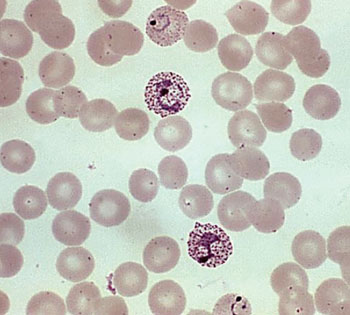Sharp Increase in Benign Tertian Malaria Observed in Migrants
By LabMedica International staff writers
Posted on 29 Jun 2016
Since 2014, the number of reported malaria cases of malaria in Europe have almost doubled compared to the previous years and clinicians are observing growing numbers of Plasmodium vivax infections, predominantly in refugees from Eritrea.Posted on 29 Jun 2016
Plasmodium vivax infections are characterized by relapses of malaria due to persistent liver stages of the parasite called hypnozoites and those relapses can be prevented currently only by 8-aminoquinoline anti-malarial drugs, such as primaquine.

Image: A photomicrograph of a blood smear containing both immature and mature trophozoites of the Plasmodium vivax parasite (Photo courtesy of Dr. Mae Melvin / CDC).
Scientists at the University Medical Centre Hamburg-Eppendorf (Hamburg, Germany) retrospectively identified all patients with P. vivax malaria admitted to the University Medical Centre from 2011 until August 2015 by the hospital coding system and data was matched with records from the laboratory diagnostics unit of the Bernhard Nocht Institute for Tropical Medicine (Hamburg, Germany).
Of the 37 Eritrean patients seen in the institution since 2014, 34 were male (92 %), median age was 19 years (range 12–37 years), and 35 % (13 patients) were younger than 18 years. One patient had a mixed infection with P. falciparum. One additional case, not included in the following statistics, had an infection with Plasmodium ovale. For 35 out of the 37 P. vivax patients, the date of arrival to Germany was known. Of those, all had arrived to Germany during the previous six months (median two weeks, range 1–180 days).
The authors concluded that countries hosting Eritrean refugees need to be aware of vivax malaria occurring in this group and the risk of autochthonous cases due to local transmission by indigenous, vector competent Anopheles species. Awareness of possible P. vivax infection in this group of patients and correct diagnosis is of major importance in order to treat the patients effectively by successive primaquine administration. The study was published on June 17, 2016, in the Malaria Journal.
Related Links:
University Medical Centre Hamburg-Eppendorf
Bernhard Nocht Institute for Tropical Medicine













